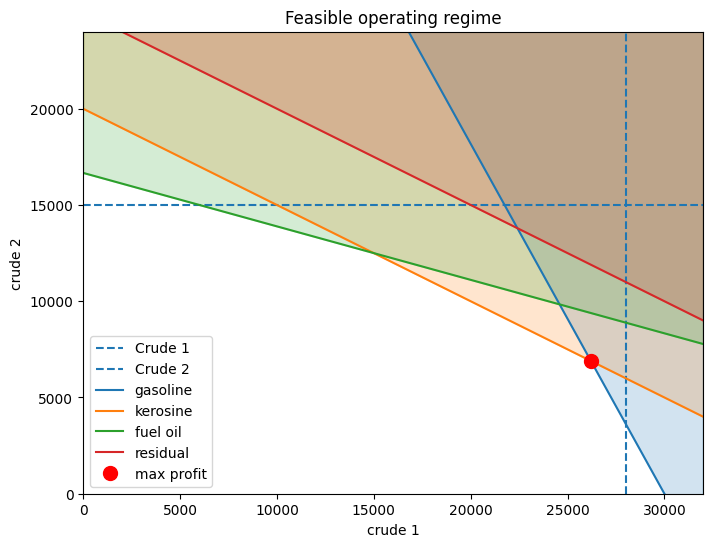Extra material: Refinery production and shadow pricing with CVXPY#
This is a simple linear optimization problem in six variables, but with four equality constraints it allows for a graphical explanation of some unusually large shadow prices for manufacturing capacity. The notebook presents also contrasts AMPL with CVXPY modeling.
# install AMPL and solvers
%pip install -q amplpy
SOLVER = "cbc"
from amplpy import AMPL, ampl_notebook
ampl = ampl_notebook(
modules=["coin"], # modules to install
license_uuid="default", # license to use
) # instantiate AMPL object and register magics
━━━━━━━━━━━━━━━━━━━━━━━━━━━━━━━━━━━━━━━━ 5.6/5.6 MB 13.4 MB/s eta 0:00:00
?25hUsing default Community Edition License for Colab. Get yours at: https://ampl.com/ce
Licensed to AMPL Community Edition License for the AMPL Model Colaboratory (https://colab.ampl.com).
%pip install -q cvxpy
This example derived from Example 19.3 from Seborg, Edgar, Mellichamp, and Doyle.
Seborg, Dale E., Thomas F. Edgar, Duncan A. Mellichamp, and Francis J. Doyle III. Process dynamics and control. John Wiley & Sons, 2016.
The changes include updating prices, new solutions using optimization modeling languages, adding constraints, and adjusting parameter values to demonstrate the significance of duals and their interpretation as shadow prices.
Problem data#
import pandas as pd
products = pd.DataFrame(
{
"gasoline": {"capacity": 24000, "price": 108},
"kerosine": {"capacity": 2000, "price": 72},
"fuel oil": {"capacity": 6000, "price": 63},
"residual": {"capacity": 2500, "price": 30},
}
).T
crudes = pd.DataFrame(
{
"crude 1": {"available": 28000, "price": 72, "process_cost": 1.5},
"crude 2": {"available": 15000, "price": 45, "process_cost": 3},
}
).T
# note: volumetric yields may not add to 100%
yields = pd.DataFrame(
{
"crude 1": {"gasoline": 80, "kerosine": 5, "fuel oil": 10, "residual": 5},
"crude 2": {"gasoline": 44, "kerosine": 10, "fuel oil": 36, "residual": 10},
}
).T
display(products)
display(crudes)
display(yields)
| capacity | price | |
|---|---|---|
| gasoline | 24000 | 108 |
| kerosine | 2000 | 72 |
| fuel oil | 6000 | 63 |
| residual | 2500 | 30 |
| available | price | process_cost | |
|---|---|---|---|
| crude 1 | 28000.0 | 72.0 | 1.5 |
| crude 2 | 15000.0 | 45.0 | 3.0 |
| gasoline | kerosine | fuel oil | residual | |
|---|---|---|---|---|
| crude 1 | 80 | 5 | 10 | 5 |
| crude 2 | 44 | 10 | 36 | 10 |
AMPL Model#
m = AMPL()
m.eval(
"""
set CRUDES;
set PRODUCTS;
param price{PRODUCTS union CRUDES};
param process_cost{CRUDES};
param yields{PRODUCTS, CRUDES};
param available{CRUDES};
param capacity{PRODUCTS};
# decision variables
var x{c in CRUDES} >= 0 <= available[c];
var y{p in PRODUCTS} >= 0 <= capacity[p];
# objective
var revenue = sum{p in PRODUCTS} price[p]*y[p];
var feed_cost = sum{c in CRUDES} price[c]*x[c];
var total_process_cost = sum{c in CRUDES} process_cost[c]*x[c];
maximize profit: revenue - feed_cost - total_process_cost;
# constraints
subject to balances{p in PRODUCTS}:
y[p] = sum{c in CRUDES} yields[p,c]*x[c] / 100;
"""
)
m.set_data(crudes, "CRUDES")
m.set_data(products, "PRODUCTS")
m.param["yields"] = yields.T
# solution
m.option["solver"] = SOLVER
m.solve(verbose=False)
print(f"Profit: {m.obj['profit'].value():0.2f}\n")
Profit: 860275.86
CVXPY Model#
The CVXPY library for disciplined convex optimization is tightly integrated with numpy, the standard Python library for the numerical linear algebra. For example, where AMPL uses explicit indexing in constraints, summations, and other objects, CVXPY uses the implicit indexing implied when doing matrix and vector operations.
Another sharp contrast with AMPL is that CXVPY has no specific object to describe a set,or to define a objects variables or other modeling objects over arbitrary sets. CVXPY instead uses the zero-based indexing familiar to Python users.
The following cell demonstrates these differences by presenting a CVXPY model for the small refinery example.
import numpy as np
import cvxpy as cp
# decision variables
x = cp.Variable(len(crudes.index), pos=True, name="crudes")
y = cp.Variable(len(products.index), pos=True, name="products")
# objective
revenue = products["price"].to_numpy().T @ y
feed_cost = crudes["price"].to_numpy().T @ x
process_cost = crudes["process_cost"].to_numpy().T @ x
profit = revenue - feed_cost - process_cost
objective = cp.Maximize(profit)
# constraints
balances = y == yields.to_numpy().T @ x / 100
feeds = x <= crudes["available"].to_numpy()
capacity = y <= products["capacity"].to_numpy()
constraints = [balances, feeds, capacity]
# solution
problem = cp.Problem(objective, constraints)
problem.solve()
860275.8615603454
Crude oil feed results#
results_crudes = crudes
results_crudes["consumption"] = x.value
results_crudes["shadow price"] = feeds.dual_value
display(results_crudes.round(1))
| available | price | process_cost | consumption | shadow price | |
|---|---|---|---|---|---|
| crude 1 | 28000.0 | 72.0 | 1.5 | 26206.9 | 0.0 |
| crude 2 | 15000.0 | 45.0 | 3.0 | 6896.6 | 0.0 |
Refinery production results#
results_products = products
results_products["production"] = y.value
results_products["unused capacity"] = products["capacity"] - y.value
results_products["shadow price"] = capacity.dual_value
display(results_products.round(1))
| capacity | price | production | unused capacity | shadow price | |
|---|---|---|---|---|---|
| gasoline | 24000 | 108 | 24000.0 | 0.0 | 14.0 |
| kerosine | 2000 | 72 | 2000.0 | 0.0 | 262.6 |
| fuel oil | 6000 | 63 | 5103.4 | 896.6 | 0.0 |
| residual | 2500 | 30 | 2000.0 | 500.0 | 0.0 |
Why is the shadow price of kerosine so high?#
import matplotlib.pyplot as plt
import numpy as np
fig, ax = plt.subplots(figsize=(8, 6))
ylim = 24000
xlim = 32000
ax.axvline(crudes["available"][0], linestyle="--", label="Crude 1")
ax.axhline(crudes["available"][1], linestyle="--", label="Crude 2")
xplot = np.linspace(0, xlim)
for product in products.index:
b = 100 * products.loc[product, "capacity"] / yields[product][1]
m = -yields[product][0] / yields[product][1]
line = ax.plot(xplot, m * xplot + b, label=product)
ax.fill_between(xplot, m * xplot + b, 30000, color=line[0].get_color(), alpha=0.2)
ax.plot(x.value[0], x.value[1], "ro", ms=10, label="max profit")
ax.set_title("Feasible operating regime")
ax.set_xlabel(crudes.index[0])
ax.set_ylabel(crudes.index[1])
ax.legend()
ax.set_xlim(0, xlim)
ax.set_ylim(0, ylim)
(0.0, 24000.0)

Suggested Exercises#
Suppose the refinery makes a substantial investment to double kerosene production in order to increase profits. What becomes the limiting constraint?
How do prices of crude oil and refinery products change the location of the optimum operating point?
A refinery is a financial asset for the conversion of commodity crude oils into commodity hydrocarbons. What economic value can be assigned to owning the option to convert crude oils into other commodities?

